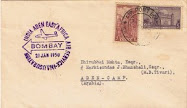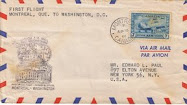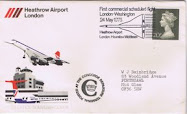
From earliest times man dreamt of imitating birds and soaring aloft. Ancient

The new machines could be advantageously used for speedy transit of mail. But before mail could be transported regularly by air the system of airmail had to prove its worth.
Though some mail was unofficially carried earlier – the world’s first official airmail was flown in
World War I, gave the impetus the aeroplane industry required. European countries used aircraft first for transmission of official dispatches and later as weapons of war. As the war progressed so did the quality of aircraft improve considerably.
All over the world experimental flights were being undertaken to explore the feasibility of regular airmails. In December,1918 Handley-Page aircraft was flown from
Airmail developments were also taking place in
The England-India route, vital to British Communication as it passed through
There were days when experimental flights were being made all over the world. Almost all countries had some sort of air service experiments during the 20s and even in the 30s. The experimental airmails soon progressed to regular airmails. During the 1920s many airline companies were formed, and by the 30s almost all countries could boast of an airline company and some sort of regular air service.
World War II brought even more development and by the end of the War the Industry had developed to a very great extent. Larger aircraft with bigger capacity and range were being built. The jet was the next development bringing Countries closer and now we are in the era of Supersonic travel. Soon, interplanetary travel will be an everyday affair.
At all stages mail has been carried which are souvenirs not only of flights but also of the adventurous spirit of man. Flight covers are a piece of history – aviation as well as postal. These covers are records of an historical period. They tell the story of the development of aviation and airmail from the early days of adventure and romance of flying to the safe, comfortable, almost plebian air travel of today. Their appeal is certainly far more than a stamp that may not have seen any postal service as in the case of a mint stamp. The First Flight Cover has a story to tell unlike an ordinary used cover with a stamp. It was actually flown in a plane, on a first flight or a special flight, on a route never before flown by an aircraft. Today we take airmail for granted. But the pioneer or first flight covers are the true forerunners of today’s most used postal service.
After World War II, Airline Companies realizing the interest of collector’s, prepared first flight covers in attractive designs with cachets. Air India First Flight covers are very attractive as are those of most airlines today. Though these covers are souvenirs prepared for collectors their appeal remains. Certainly they have much more to say than the specially prepared First Day Covers. They are souvenirs of a new route by an Airline or of a new plane. When the Boeing 747 ‘Jumbo’ was introduced all airlines carried mails on the inaugural flights though on old routes. But the covers are pieces of historical interest – the history of a new aeroplane service.
Today the accent is on collecting postal history items and its popularity is growing. What branch of postal history could be more fascinating than the story of man’s conquest of the air and the speedy delivery of mails to hours or day instead of weeks or months?
Flight covers can add flavor to a country stamp collection. Flown covers representative of the airmails of your country can enrich and make your collection postally and historically complete.
The investment potential of flight covers is very great. The Pioneer airmen carried few pieces of mail on early flights. Even later the number of covers carried by airlines are very much smaller compared to the number of First Day Covers sold on the first day of issue of a new stamp. As more and more people turn to postal history the prices of early and scarcer airmail covers are bound to go up. Why not start now before its too late.
In future post I'll deal with various topics relating to aero-philately. Keep checking












No comments:
Post a Comment